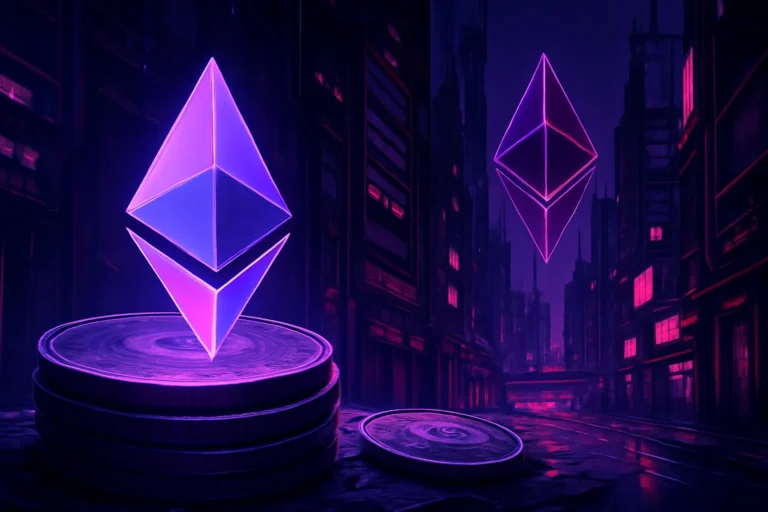The next chapter of Ethereum Tokenization News just moved from theory to practice. FG Nexus, an ETH-focused treasury company listed on Nasdaq, has entered an agreement with Securitize to tokenize both its common stock and its dividend-paying preferred shares directly on the Ethereum blockchain. If successful, this will make FG Nexus one of the earliest Nasdaq-listed companies to bring natively tokenized, rights-equivalent equity on chain—where ownership, compliance, and settlement can be automated in code.
This deal is more than a headline for crypto insiders. It’s a signal that real-world assets (RWA)—in this case, actual exchange-listed equity—are stepping onto public blockchain rails under established U.S. securities oversight. Securitize, a registered broker-dealer, transfer agent, fund administrator and operator of an SEC-regulated alternative trading system (ATS), will provide the compliant infrastructure for issuance and trading, while Ethereum supplies the programmable settlement layer.
Below, we unpack what FG Nexus announced, why it matters for investors and markets, how on-chain security token mechanics differ from traditional equity plumbing, and where ETH tokenization could go next.
What exactly did FG Nexus announce—and why now
FG Nexus (ticker expected as FGNX for common and FGNXP for preferred) agreed to let shareholders elect to convert their regular shares into natively tokenized equivalents on Ethereum through Securitize’s platform. The company also plans to bring a dividend-paying preferred stock fully on chain, positioning it as a first for U.S. exchange-listed, on-chain dividend equity. The tokenized shares are designed to preserve the same legal rights as their off-chain counterparts while adding features like near-instant settlement and automated compliance checks.
The timing aligns with FG Nexus’s broader corporate pivot. Earlier this summer, the firm (formerly Fundamental Global) closed a $200 million private placement and unveiled an Ethereum treasury strategy, rebranding to emphasize its ETH-centric focus. That war chest is earmarked for accumulating ETH, staking, and related initiatives—making equity tokenization a strategic complement that keeps investor exposure, corporate capital, and market infrastructure all inside the Ethereum economy.
Who are the players A quick profile of FG Nexus and Securitize
FG Nexus: From investment company to ETH-native treasury
FG Nexus describes itself as an Ethereum-focused asset manager building an ETH reserve, generating yield via staking and restaking, and exploring RWA tokenization to “build the future of finance.” It recently restructured its capital strategy around ETH accumulation and has even secured shareholder approval to massively expand authorized shares, creating flexibility for future on-chain corporate actions.
Securitize: A compliance-first bridge between securities and blockchains
Securitize is one of the most established names in tokenized securities. Through its subsidiaries, it operates as an SEC-registered broker-dealer, digital transfer agent, fund administrator, and ATS operator, and has worked with major asset managers on tokenized funds and private market products. Its stack handles investor onboarding (KYC/AML), cap table management, transfer restrictions, and secondary trading—all crucial for on-chain equities to remain compliant under U.S. law.
How native tokenization of equity works on Ethereum

In many tokenization schemes, an intermediary issues a wrapped or synthetic token that mirrors an off-chain asset. FG Nexus is pursuing native tokenization: the blockchain token is itself the share, with rights aligned to the underlying corporate documents and transfer agent records. Legally, this approach intends to avoid the gray zone where tokens are mere representations; instead, the token is the security, recorded and administered within a compliant framework.
With Securitize, token issuance embeds rules (who can hold, transfer limits, lock-ups) directly into the smart contract. Transfers occur only when conditions are satisfied—think of it as compliance baked into code. When shares trade on Securitize’s ATS, settlement can finalize near-instantly, eliminating the T+2 lag common in traditional markets. The result: a single source of truth for the cap table, fewer reconciliation errors, and programmable corporate actions (e.g., recording dates for dividends) that can be automated.
Why this matters: Investor access, liquidity, and programmable equity
Tokenized equity often promises broader access. Investors onboard digitally, complete compliance checks once, and then hold shares in a wallet—custodied or self-custodied—subject to the issuer’s rules. Combined with an ATS that can operate with extended hours, liquidity windows can expand beyond traditional market sessions. For preferred stock like FGNXP, on-chain dividends could be scheduled and distributed programmatically to eligible holders at the block level.
For FG Nexus, this also cements its identity as an ETH-native corporate, aligning treasury strategy (ETH accumulation and yield) with investor experience (on-chain ownership). As Ethereum tokenization accelerates across funds, credit, and real estate, public-company equity moving on chain is a powerful signal that the infrastructure is becoming mature enough for regulated issuers.
Ethereum’s role: Why build on ETH?
Ethereum offers an open, programmable settlement layer with the largest developer ecosystem and the broadest menu of DeFi and RWA integrations. Standards (ERC-20, ERC-1400 family for security tokens, ERC-4626 for vaults) and battle-tested custody plus key management tools make ETH the logical home for tokenized securities. For a treasury company committed to ETH, issuing equity on Ethereum creates network effects: holders can see balances in wallets, issuers can automate actions, and third parties can build services around a common standard. (Industry context from Securitize’s work across multiple tokenized funds further underscores Ethereum’s primacy.
The market backdrop: From mirrored stocks to native shares
Over recent months, tokenization headlines have ranged from mirrored stocks and ETFs (synthetic representations tradable within crypto ecosystems) to tokenized funds from major managers. But FG Nexus is charting the native route—where the token is the equity and carries identical rights—rather than issuing synthetic copies. That distinction marks a pivot from speculative proxies toward regulated, on-chain ownership recognized by corporate law and transfer agents.
Compliance, KYC, and transfer restrictions: The “boring” superpower
The biggest misconception about tokenized equities is that they trade freely like meme coins. In reality, compliance constraints are the point. Securitize’s ATS and transfer agent functions make sure only qualified investors can hold or trade specific share classes and that resales follow Rule 144 or Reg S conditions when applicable. These constraints can be encoded into the token, so even a misdirected transfer will fail if rules aren’t met. In practice, that makes tokenized equity safer for issuers and regulators while giving investors the UX benefits of blockchain.
FG Nexus’s ETH treasury strategy: Why it matters to equity holders
FG Nexus’s decision to build an ETH treasury—funded by the $200 million private placement—turns its balance sheet into an on-chain macro bet. For holders of tokenized common or preferred stock, that can translate into transparent, programmatic reporting of treasury positions, and potentially on-chain proofs of reserves or validator yields over time. It also aligns incentives: if the company’s core thesis is Ethereum’s growth, bringing its shares to Ethereum reduces friction for ETH-native investors to participate or provide liquidity.
What about dividends and corporate actions on chain?
The marquee feature of the FG Nexus announcement is the plan to bring a dividend-paying preferred (FGNXP) fully on chain. Historically, dividend processing required multiple intermediaries and cut-off dates. With on-chain shares, record dates and distributions can be coordinated in smart contracts, with payouts streaming to compliant wallets. That reduces errors, shortens timelines, and could enable innovations like more frequent distributions or transparent accruals—while still mapping to established corporate and tax rules.
Liquidity and trading: From T+2 to near-instant settlement
Traditional equities settle on T+2—two business days after a trade—introducing counterparty risk and operational overhead. Securitize’s ATS can clear near-instantly on Ethereum, subject to network finality and platform rules. For market makers and investors, faster settlement can reduce capital tied up in the clearing process, support 24/7 trading windows (as permitted), and enable composability with other on-chain financial services over time.
How this compares to other tokenization efforts
While mirrored stocks and token markets have existed for years, native equity tokenization by a Nasdaq-listed company remains rare. FG Nexus’s step joins a growing wave of tokenized funds and credit products, but sets itself apart by putting public common and preferred shares on chain under a regulated transfer agent + ATS stack. As press coverage notes, this puts FG Nexus among the first cohort bringing dividend-paying, exchange-listed equity directly to Ethereum.
Risks and open questions investors should watch
Regulatory evolution and disclosures
While Securitize’s registrations provide a clear compliance path, policy around continuous 24/7 markets and cross-venue interoperability is evolving. Investors should monitor issuer filings and disclosures on how tokenized and legacy share registries reconcile, and what happens during corporate events like splits or redemptions. Newsflow indicates regulators are actively studying on-chain market structures, which could accelerate or slow adoption. (Context on the SEC’s exploration of 24/7 trading has been widely reported alongside tokenization coverage.
Wallet security, custody, and recovery
Owning tokenized shares in a wallet raises practical questions: What if you lose your keys? How do you assign voting proxies? Who custodies assets for institutions? Fortunately, regulated transfer agents can typically re-issue in certain circumstances and manage corporate actions, but investors should understand their platform’s specific procedures and whether they’ll self-custody or use an approved custodian.
Liquidity fragmentation and venue choice
If multiple ATSs or venues support tokenized shares over time, liquidity could fragment. Standards for interoperability, common identifiers, and unified compliance checks will be crucial. Issuers and platforms may need to adopt shared token standards and APIs to prevent walled gardens.
The broader picture: Why on-chain equity matters for Ethereum
Ethereum tokenization news often focuses on funds or private credit. Public equity is more complex—but also more transformative. Tokenized stocks let issuers execute programmable finance: time-locked unlocks for employee equity, instant settlement on M&A close.
,Collateralizing on-chain shares for credit with transparent risk parameters. As Ethereum’s RWA stack matures, equities can plug into DeFi components (under compliance constraints), letting capital flow more efficiently between corporate finance and decentralized markets.
Read more: Bitcoin Tax Implications News 2025 New IRS Rules & Form 1099-DA Guide
What it could mean for ETH: Demand, fees, and staking

If public companies increasingly issue and trade on Ethereum, blockspace demand rises. More transactions mean more fees (gas), potentially increasing ETH burn under EIP-1559 dynamics, while staking secures the network that hosts these securities. For a firm with an ETH treasury, that’s a reinforcing loop: the more finance migrates on chain, the more valuable secure, scalable blockspace becomes. FG Nexus’s $200M raise to accumulate ETH and pursue this strategy shows a corporate vote of confidence in that direction.
Practical next steps: How investors might participate
Subject to jurisdiction and platform rules, investors typically must create a Securitize account, complete KYC/AML, and link a compliant wallet or choose custody. For existing FG Nexus shareholders, documentation indicates there will be mechanisms to elect conversion into tokenized shares. Further details should come from official issuer communications and Securitize onboarding flows as the rollout proceeds.
Competitive and ecosystem implications
For other issuers, FG Nexus’s move delivers a blueprint: partner with a compliance-first platform, map corporate rights to a security token standard, and use an ATS that can handle near-instant settlement. For exchanges and brokers, tokenized equities will challenge legacy rails with round-the-clock markets and programmable features. For regulators, on-chain auditability can enhance market surveillance—every transfer, timestamped—even as new questions arise around fair access and cross-venue routing.
How we got here: The road to October 2025
On July 30–Aug. 5, 2025, FG Nexus’s rebrand and $200M financing set the stage for an ETH-centric corporate identity, including plans to list under FGNX/FGNXP and accumulate ETH as a primary reserve asset. By October 2, 2025, the company announced its partnership with Securitize to tokenize both common and preferred shares on Ethereum, aiming to become the first to bring a dividend-paying, exchange-listed preferred fully on chain. The throughline: a corporate strategy built around Ethereum at the treasury, infrastructure, and investor-experience levels.
Technology notes: Smart contracts, standards, and the investor UX
Behind the scenes, tokenized equity on Ethereum typically uses smart contracts that enforce transfer restrictions and track whitelists of eligible wallets. While the specific contract standard may vary, security-token frameworks like ERC-1400 and compliant transfer hooks are common patterns. Securitize’s stack abstracts much of this complexity so investor UX feels familiar: onboard, get verified, view holdings, and trade within the approved venue—except settlement occurs on chain, visibly and verifiably.
The bottom line: From press release to programmable public equity
If executed as described, FG Nexus’s tokenization initiative is poised to be a milestone for Ethereum tokenization and on-chain capital markets. It suggests a future where public companies operate with blockchain-native registries, dividends, and cap tables—without sacrificing regulatory compliance. For investors, it promises faster settlement, greater transparency, and a path to wallet-native ownership of regulated assets.
As tokenization evolves from funds and credit into public equity, the long-predicted bridge between Wall Street and Web3 is no longer conceptual. It’s deploying—one ticker at a time.
Conclusion
FG Nexus’s partnership with Ethereum Tokenization News not only because it tokenizes Nasdaq-listed shares on Ethereum, but because it aligns an issuer’s treasury, technology, and investor experience around a single programmable network. With compliant issuance, an SEC-regulated ATS, and native tokenization that preserves shareholder rights,
This move showcases how real-world asset tokenization can work for public companies—not just in pilots, but in production. If FG Nexus’s rollout proceeds smoothly, expect more issuers to follow, pushing equity markets toward on-chain settlement, automated compliance, and programmable corporate actions that make today’s back-office processes feel archaic.
FAQs
What does “natively tokenized” mean compared to mirrored or synthetic stocks?
“Natively tokenized” means the blockchain token is the legally recognized share, administered by a transfer agent, with the same rights as traditional shares. Mirrored or synthetic tokens simply track an off-chain asset and may not carry legal ownership rights. FG Nexus’s deal indicates a native approach with rights parity and on-chain settlement through Securitize’s regulated infrastructure.
How will dividends work for the tokenized preferred shares (FGNXP)?
FG Nexus plans to bring its dividend-paying preferred fully on chain. In a compliant setup, record dates and distributions can be programmed into smart contracts, with payouts sent to eligible, whitelisted wallets—reducing reconciliation errors and delays common in legacy systems.
Can anyone buy and trade the tokenized shares on Ethereum?
Access depends on jurisdiction, KYC/AML status, and the issuer’s rules. Securitize’s ATS operates under SEC oversight and enforces transfer restrictions in smart contracts, so only approved investors with verified wallets can hold and trade the shares.
Why is FG Nexus doing this on Ethereum rather than another chain?
Ethereum offers the deepest developer ecosystem, mature custody options, and widely used token standards. For a company with an ETH treasury, aligning issuance and settlement on Ethereum builds network effects across treasury operations, investor UX, and future integrations with DeFi and RWA platforms.
What earlier steps set the stage for this announcement?
FG Nexus rebranded from Fundamental Global, closed a $200 million private placement, and articulated an ETH-centric treasury plan—then announced the Securitize partnership on October 2, 2025 to tokenize both common and preferred shares on Ethereum.


